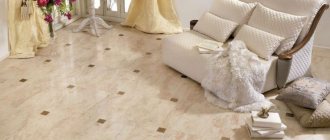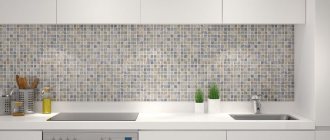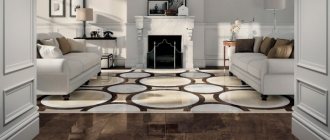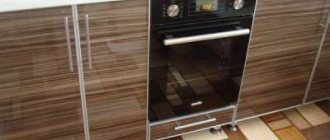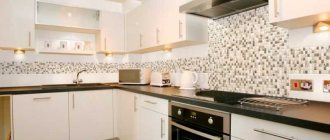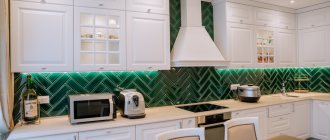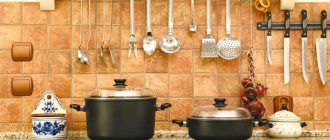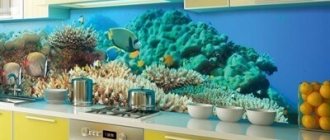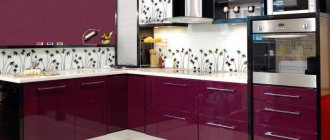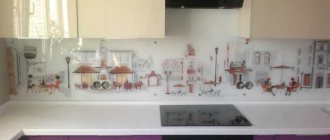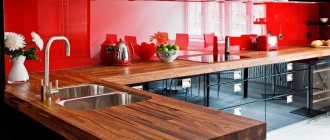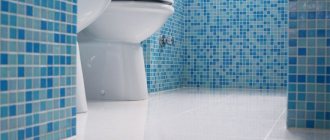Pros and cons of tiles for kitchen backsplash
The market offers so much! To understand why tile is still popular, let's talk about its advantages:
- this is the material that is not afraid of moisture, but next to the stove there is always the most splashes and fumes;
- the tile does not react to kitchen temperatures, since it was made at ultra-high temperatures; ordinary heat in the kitchen will not harm the tile;
- all traces of grease and dyes can be easily removed from the tiles without leaving any traces;
- good installation and high-quality material will allow you to admire the tiles after decades;
- modern color and texture options will suit the most demanding owner;
- tiles can be combined in design with any other material.
Now let's look at a few disadvantages:
- In order for the apron to last a long time and look impeccable, tile laying skills are required, or you will have to invite a specialist;
- during work, the kitchen must be empty, which can create some difficulties;
- additional materials are required to fix the tiles;
- During the entire period of using the apron, you need to monitor the tile seams and adjust them.
Any material has advantages and disadvantages, but in the case of using tiles for a kitchen backsplash, there are still more advantages.
Mirror tile backsplash
The mirror surfaces on the kitchen apron shimmer in an original way, illuminating the work area. This type of tile is used to visually expand small kitchen spaces.
This model has a high cost per cubic meter of tiles, so careful calculation of consumables is necessary.
Types of glossy and matte ceramic tiles for backsplashes
Glossy or matte - it depends on the desire of the owner and the general requirements of the design of the room.
Gloss always looks glamorous and creates the impression of luxury
The gloss effect is provided by the reflection of light, which makes the space look visually larger.
Advice! If the kitchen environment is not conducive to “immodesty,” then it is better to opt for matte tiles.
The disadvantage of glossy tiles is the appearance of stains with frequent washing. Matte tiles look more neutral and do not cause a “loud” feeling.
The matte finish on the apron creates a cozy and comfortable feeling
There are not so many difficulties with cleaning a matte apron, and dirt on it is not as noticeable as on a glossy one.
Mosaic tiles for kitchen backsplash
Mosaics have been in demand for several centuries. These are small tiles made of glass or ceramics. Its small size allows it to be used as laid out designs and ornaments.
The posted drawing looks very original
Color accents play in a new way with such an apron
Mosaic tiles are good for both small kitchens and large dining spaces
Laying mosaic tiles on a kitchen backsplash is quite a troublesome task. The miniature size of the tiles requires certain installation skills.
The cost of a mosaic apron will be slightly more expensive than many other options.
Useful service:
Especially for our readers, we offer you to use a convenient online kitchen designer , which allows you to organize the kitchen space to your taste and quickly calculate the cost of the kitchen set.
For the best results, it is worth contacting professional tile layers to avoid disappointment with the result. The options for combining colors in a mosaic are not limited in any way, because you can create real paintings. But it is possible to choose from several colors.
Mosaic patterns and plain kitchen furniture create a pleasant impression
Ornaments can fit perfectly into a certain style of kitchen
Related article:
The best option for decorating the cooking area are kitchen aprons - skinali , photos of which are presented in our review. Read on to learn why they have become so popular.
Tile "hog"
The tiles got their name because they were previously made using a mold with holes similar to a boar's snout. The modern “hog” is a small rectangular glossy tile, elongated in a 1:2 ratio.
Typically used sizes are from 7×12 to 10×25 cm
The “hog” tile is produced with a beveled bevel, that is, the edge of the tile is cut off at a certain angle to the surface.
The “boar” is always the same color, but the rich range of colors allows you to find what you need
This type of tile is very suitable for the classic design of the kitchen.
Despite the apparent simplicity of the tiles, the apron in the kitchen looks aesthetically pleasing, simple and at the same time original. The installation should be done by a professional who can correctly form the outer and inner corners.
Related article:
Kitchen apron made of plastic. Why you need it, pros and cons, types, selection criteria, overview of manufacturers and average prices, subtleties of self-installation, useful tips - in our publication.
Metlakh tiles
Tiles that are as durable as porcelain tiles are heat-resistant, moisture-resistant, and can withstand acids. In combination with external beauty, Metlakh tiles are ideal for a backsplash in the kitchen.
The small format of the tiles allows you to create very ornate geometric patterns
This tile will appeal to fans of the creative use of loose geometry in the interior.
An apron makes the room oriental in color
The ability to choose delicate colors allows you to use Metlakh tiles in many styles
Which tiles should you prefer - matte or glossy?
Before making your final choice, you should consider all the advantages and disadvantages of both options.
Glossy tiles - this finishing material has a sparkling surface, so it can decorate any room, including the kitchen. Glossy tiles look especially good in small spaces, as they visually expand the space and fill it with light.
And such tiles are also very easy to care for; any dirt is quickly washed off from its surface, even without the use of special products. Glossy tiles are often chosen for installation in rooms with low light. Another advantage of the material is the ability to use it in a wide variety of kitchen interiors.
Matte tiles - their surface does not shine, the material looks quite modest and simple. A kitchen apron made of matte tiles will emphasize the refined taste of the homeowners, as it looks noble and discreet. The main thing is that there is enough lighting in such a room. This material helps to avoid unnecessary glare. Despite the lack of gloss, it is quite easy to care for.
Types of glass tiles
The glass apron in the kitchen is called skinali. The advantages of such an apron include its non-absorption of water and grease, and the glass is easy to clean. Cloths with lint, specially designed for cleaning glass, will remove even the slightest stains without leaving a trace.
With ordinary tiles, dirt gets into the joints, but with skinned tiles there is no such disadvantage
On black glass, flaws during washing will not be noticeable at all, and the effect in the design is amazing
Modern manufacturers offer both transparent glass aprons and colored ones. The glass can be frosted or placed in a special way.
The photo panel on the apron looks impressive
Photos can also be placed between sheets of glass or using the technique of photo printing on glass and sintering.
Glass apron is resistant to mechanical damage
The installation of such an apron is clean and hassle-free: there is no need to remove furniture from the room.
Related article:
Glass kitchen apron. Catalog, photos, advantages, varieties, selection criteria, model range, secrets of do-it-yourself installation, advice and recommendations from experts - you will find in the material on our portal.
Why are tiles suitable for finishing a kitchen backsplash?
Tile is considered one of the most reliable materials for covering floors and walls. It is resistant to stains and easy to clean, which is why tiles are often preferred when decorating rooms with high humidity levels.
Using tiles, you can create a variety of effects, for example, highlighting a certain area.
To make ceramic tiles, manufacturers use a mixture of sand, several types of clays and minerals. All this is carefully pressed, after which it is fired, then covered with enamel and fired again.
This material is relatively light in weight and has high strength and resistance to mechanical damage.
Tile has numerous advantages:
- resistance to temperature changes - it is a fire-resistant, non-combustible material that can withstand the highest temperatures and retain its external decorative characteristics;
- water resistance - the level of water absorption by the tiles is very low, so this material never swells or warps, its color and shape always remain the same;
- inertness to chemical reagents - the tile is not afraid of alkali and acid, so when caring for it you can use any household chemicals;
- smooth surface with high density - microbes do not multiply on it and foreign substances are not absorbed;
- durability - tiles can last for many years, remaining the same as on the day of purchase;
- easy to maintain - to keep the tiled apron perfectly clean, just wipe it periodically with a damp sponge.
Types of stone and porcelain tiles
Ceramic tiles, called porcelain tiles, have special properties, among which strength comes first. The sophistication of the interior, in which porcelain stoneware was used on the apron, seems like an expensive luxury.
Porcelain tiles are good because they are resistant to grease and dirt
Expert's point of view
Yaroslava Galayko
Lead designer and studio manager at Ecologica Interiors
Ask a Question
“A porcelain stoneware backsplash can be paired with a countertop made of the same high-strength material.”
According to the Mohs scale, the hardness of porcelain stoneware is 9 points, so it is very difficult to work with it yourself.
It is better to order such a kitchen apron from specialists
Another option for stone apron design is agglomerates. This material is made using polyester oils and inclusions from granite, marble and limestone chips. Adding dyes allows you to obtain interesting color shades that are close to natural stone.
The weight of such an apron is less than that of a porcelain stoneware one, but the beauty is just as great.
Seamless technique for laying artificial stone - perfect evenness of lines
For porcelain stoneware, there is only one installation method possible - cladding with slabs, so a monolithic slab is often ordered, which guarantees the durability of the apron.
Standard formats of tiles for apron
The tile format is selected based on personal preferences, ease of installation, material for the apron, as well as the overall dimensions of the furniture, hob, and the height of the furniture in the kitchen. The popular size of tiles for a kitchen splashback is 10x10 cm. This is the optimal size that can be combined with any decor and idea.
When using tiles of this size, it is very convenient to make calculations: the result is always neat and geometrically correct
A distance of 60 cm is recommended between the countertop and the wall cabinet: it turns out that tiles measuring 10x10 cm will fit well in six rows.
Important! The actual parameters of the tile are always chosen slightly less than the planned volume of coverage - to take into account future seams.
While domestic manufacturers still produce a large selection of tiles in these sizes, foreign manufacturers consider this format old-fashioned.
Simple and beautiful tiles for the kitchen on an apron 10x10 cm
Color and decor of tiles for a kitchen apron
This is where you can let your imagination run wild, and that’s when choosing tiles for a kitchen backsplash. They take into account the general style of the room, decorative elements, color of furniture, taste preferences, and also focus on the mood that should be created when entering the kitchen.
Patchwork style tiles for a backsplash in the kitchen
The patchwork style will bring brightness to the kitchen: rich shades and color combinations fill the room with energy. Each design decision becomes individual.
Laying of multi-colored modules occurs in a certain order
It turns out to be a kind of patchwork blanket that creates the warmth of comfort.
Nobody forbids experimenting with elements of a wall “bedspread”
Laying such an apron with your own hands is a very interesting process.
Wood or stone backsplash tiles
Natural wood is not used to decorate a kitchen apron - in addition to the fact that it is not cheap, it is simply impractical and dangerous. But if you want to see wooden apron surfaces in the kitchen, use MDF or laminated chipboard with a thickness of 4 to 15 mm.
The advantages of this design include ease of installation, the ability to select a combination of wood and stone materials
You should not install such a covering next to a gas stove.
Wood-colored porcelain tiles will be safe and will fit seamlessly into a wooden kitchen
Brick design in the kitchen interior fits perfectly into many styles
Imitation of marble, salt marsh, slate with artificial aging, irregularities, roughness makes the interior impressively special.
Selecting tiles by size
Today, there is a whole range of tile sizes for kitchen backsplash design. In this case, tiles play not only a decorative role.
Correctly selected module sizes allow you to optimize a small room or a kitchen with a non-standard shape. For example, standard size tiles are suitable for a room of any size, and XXL class modules are only suitable for large kitchen spaces combined with a dining area.
Mosaics, the modules of which are very small in size, are perfect for visually expanding a small kitchen.
All models, their design features, sizes, photos can be seen in the backsplash tile catalog and you can make your right choice.
New backsplash tiles from popular manufacturers
Competition in the world of building materials manufacturing is always high. Russian, Spanish and Italian tiles are in particular demand. This is a colossal selection of colors, textures, sizes. Depending on the quality and exclusivity, the price range is also built.
Russian kitchen tiles for backsplash
Russian manufacturers work focusing on the economic processes in the country: quality does not suffer from quite affordable prices, but new collections of ceramic tiles are regularly released. The work is carried out using high-quality equipment using European technologies.
Neutral shades suit any style
A traditional ornament or pattern will refresh the kitchen
Brands that have a good track record and recommendations: Shakhty tiles , Kerama Marazzi , Atlas Concorde Russia , Ceradim , Uralkeramika and others.
Spanish tiles for kitchen backsplash
Spain has established itself as a high-quality and serious manufacturer of ceramic tiles for kitchen backsplashes. These are mainly tiles of neutral shades, often successfully imitating wood or stone.
The inclusion of decorative elements in combination with plain walls attracts the eye
A whole decorative ensemble of a beige background, border and small panels
The Spaniards are big fans of tiled borders on kitchen aprons
Octagonal Spanish tiles look interesting
Spanish manufacturers in their collections focus on the comfort of the room.
Italian kitchen tiles for backsplash
The unconditional design effect and richness of color schemes belong to Italian manufacturers of ceramic tiles. The prices for such products can be said to be astronomical. But quality combined with beauty justifies the high cost of the product. Below in the photo are examples of ceramic tiles for the kitchen on the apron.
Traditional kitchen design in the Italian spirit
Modern lavender tones make the kitchen soft and romantic
Natural colors are also welcomed by Italians
Yes, Italians know a lot about chic interior design.
What to look for when buying backsplash tiles
Despite modern trends towards non-standard interior design and the tendency towards dark colors, an apron in such colors is impractical. The slightest splashes, stains, dust - all this will immediately attract attention, distracting from the overall interior and decor. But when choosing bright colors for the apron, it is important not to overdo it and make the rest of the kitchen tones neutral.
Due to the correctly selected material, you can significantly visually expand the space: skinali with a horizontal pattern or a “hog” will do. Although a mirror finish will make the room visually wider, imagine how many imperfections will be noticeable on the mirror surface! When choosing a tile, add 10% to the calculated quantity for possible errors or chips.
Also, take the time to check the product you are purchasing for damage. We also want to say that porous surfaces for the kitchen are not the best option. Although it is beautiful, dirt gets clogged into such material very quickly.
How to lay a tile apron in the kitchen with your own hands - nuances
To make a kitchen apron from tiles, follow a few tips:
- Carry out marking of the coating.
- Use chalk to mark the places where patterns or drawings will be located.
- The wall is covered with a layer of primer, using it sparingly.
- The lower border is indicated by a metal or wooden profile.
- Be sure to use a building level for leveling!
- Make sure that the adhesive composition has less contact with air, since the installation process is not fast, and the glue can dry out. They don't skimp on glue and spread an impressive layer.
- Go over the glue with a notched trowel and set up the first row.
- Do not forget to use plastic crosses for the quality of the seams.
- If necessary, use a grinder with a diamond blade or a tile cutter.
- If glue gets on the front side, wipe it off immediately.
- The next day, the joints are cleaned of excess glue and the crosses are removed.
- All that remains is to apply a protective coating for the joints and grout.
Photos of interesting design options for a tile apron
At the end of the article, we suggest looking at different kitchen interiors with tiles on the apron. Perhaps you will find an interesting design solution for yourself.
Modern lavender tones make the kitchen soft and romantic
White kitchen backsplash tiles refresh the interior
The patchwork style is amazing!
Modern design: you’ll want to cook in a kitchen like this all the time!
Soft brown tones are just what you need after a long day at work.
Tiles everywhere - a non-standard solution for kitchen furniture
Mottled corner? Amazing!
Coffee shades do not make the room gloomy
The combination of white and blue will always be held in high esteem
Did you admire it? What will your kitchen design be like? If you already know the answer to this question, share your experience in choosing materials for repairs in the comments.
Which grout to choose for tiles
For an expert, there is nothing difficult about laying kitchen tiles, but for a beginner who needs to cope with outside corners, it will not be so easy. Particular attention should be paid to seams, a contrasting joint should be chosen, and the layout and sealing should be of simply excellent quality. To play it safe, it is better to choose a more standard solution, which can be:
- white;
- grey;
- beige.
The solution must be of high quality, not afraid of moisture, frequent washing and temperature changes. If you are on a budget and choose a cheaper option, be prepared that the grout will darken very quickly and will not have an aesthetic appearance. The best solution in this case is epoxy resin powder. This moisture-resistant substance that repels dirt does not darken even over time, the only drawback is that all actions must be performed very quickly, otherwise the composition will simply dry out. For the same reason, tiles should be chosen in small areas for laying, otherwise there may not be time to clean the surface and the joints will harden.
The solution is removed with a special composition, which can then be used as a detergent for ceramic surfaces.
